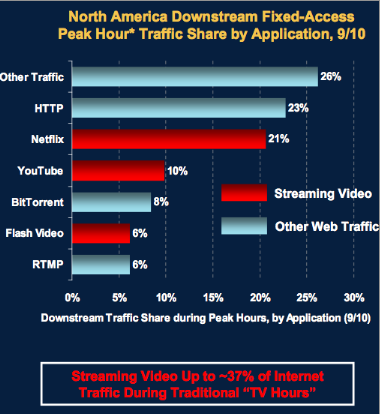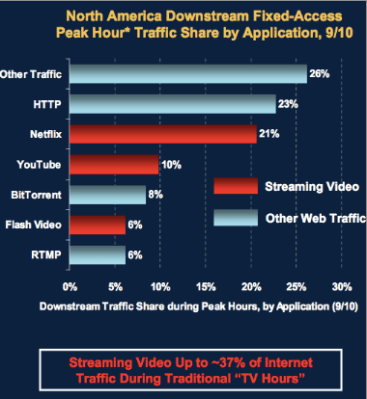
A few weeks ago, some data came out suggesting that Netflix alone accounts for 21 percent of Internet traffic during peak TV hours. But if you add in a couple other sources of streaming video from the Web, namely YouTube and other forms of Flash video, the traffic share of Web video jumps to 37 percent (with 10 percent from YouTube and 6 percent fro Flash video). BitTorrent is another 8 percent, with much of that being video as well.
These startling numbers were put together in a slide by Morgan Stanley Internet analyst Mary Meeker during her presentation at the Web 2.0 Summit earlier this week. All HTTP web traffic is only 23 percent of the total.
Does this mean that the No. 1 activity on the Web is watching videos? Not exactly. The traffic is measured in terms of bandwidth used and how many bits are transferred. Streaming a video file requires an order of magnitude more bits than loading a Web page. As a result, video is hogging up the bandwidth.
And the longer the video, the more bandwidth it requires. Which perhaps explains why Netflix accounts for twice as much bandwidth usage as YouTube. People are streaming full-length two-hour movies from Netflix, not two-minute video clips. People are still watching a lot more videos and spending more time on YouTube. In October, viewers spent 23.4 billion minutes on YouTube compared to 750 million minutes on Netflix.com, according to comScore. And YouTube attracted 116 million unique visitors versus 20 million for Netflix.
When you see these numbers, just remember that what they are measuring is the traffic load on the Internet in terms of bandwidth consumed, not time spent. Still, if video is eating up more than a third of Internet bandwidth during primetime hours, imagine what it will be if a decent TV experience ever comes to the Web.
